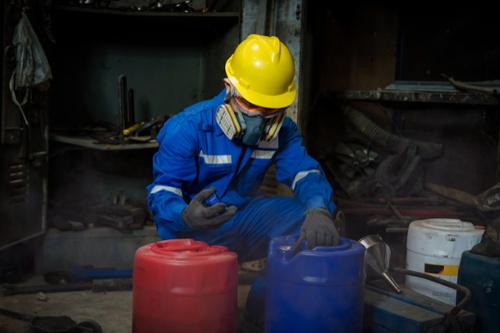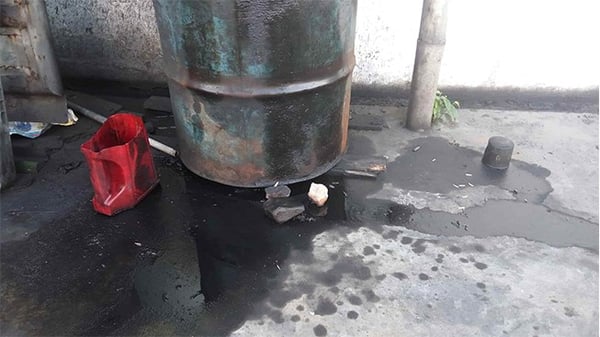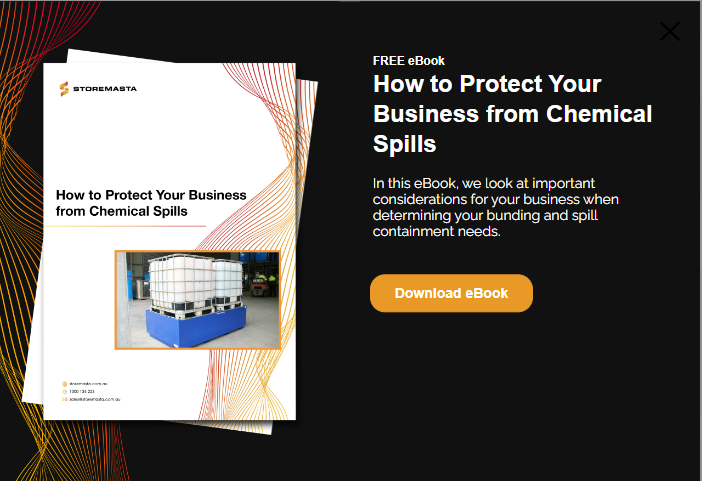If you’re dealing with an accidental release of chemicals, you need to act decisively. That means being equipped with the knowledge, experience and tools to successfully assess and manage a minor chemical spill. The longer hazardous chemical spills sit in a workplace environment, the greater the likelihood and impact of risk. A minor chemical spill, such as an overturned container or a leaking piece of equipment, must be controlled to reduce the risk of ignition, harmful vapours, chemical reactions — and even workplace falls or injuries caused by staff making unintentional contact with the substance.
When a leak or spill is first noted in the workplace, the process of identifying and managing the spill will immediately commence. In this post, we’ll be looking at the key factors involved with minor chemical spill clean-ups including determining whether it’s a major or minor spill, eliminating further risks, and utilising the correct spill kits for the clean-up and disposal.
Notification of the Chemical Spill
Does your workplace have a spill response plan in place that details how personnel should respond if they notice a chemical leak or spill?
Giving all staff the training and procedures to understand how to notify supervisors of a chemical spill is one of the simplest ways that you can heighten the safety of your chemical usage, handling, transfer and storage areas.

All staff should have the knowledge of how to notify the relevant supervisors of a chemical leak or spill.
Regardless of whether your staff member is an administrative assistant or a loading dock worker, staff must be educated about the importance of notifying the appropriate supervisors if they notice leaks or spills (or even unusual vapours) throughout the workplace.
Have a set procedure in place where staff have clear instructions on who to contact when an accidental release occurs. Make sure that staff do not touch or go near the leak or spill. This may include staff placing hazard signage around the spillage to prevent further pedestrian access. Ensure that supervisors and/or the spill response team are immediately called upon so more comprehensive hazard prevention measures are put in place.
Determining the Severity of the Spill
The first thing your supervisors and/or spill response team will have to work out is if the spill is classed as a minor or major incident.
But before we get to that, we need to first understand the difference between a minor spill and a major spill incident.
Minor spills are those accidental chemical releases that can be safely managed by your inhouse team, without the need to contact emergency services and notify the relevant regulatory authorities.
Minor spills may appear in many forms, such as:
- leaking diesel from a truck fuel tank
- petrol pooling underneath equipment
- a tin of chemicals knocked over in a workshop
- an overflowing bund that hasn't been maintained properly
- cracked chemical container in an unbunded area
- spilled cleaning fluids
- tins of paint that have been knocked over
- a lab vile that’s been broken
Many of these minor spills may occur regularly in your business, however, they can still pose risk to people, property and the environment if they're not tended to promptly — and with the correct equipment and procedures.

Understanding when to notify emergency services of a spill is a key part of your spill assessment.
It's important to determine if the spill is minor or major, as major spills require the actioning of emergency evacuations and emergency response plans, in conjunction with the relevant emergency services. An example of a major spill would be an incident such as a tanker overturning, a large volume of corrosive liquids spilling into an unbunded zone, or a drum of flammable liquids spilling into an area with live ignition sources or incompatible substances.
IMPORTANT: Major spills must be noted and communicated with the regulatory body in your state or territory, as per the Work Health and Safety laws of your region.
How to Assess Whether it’s a Major or Minor Spill
When assessing whether a spill is classed as minor or a major chemical spill, you can go through the essential steps of our chemical spill decision tree flowchart.
The steps include determining if the chemical:
- Poses an immediate fire hazard
- Quantity of spillage presents a danger
- Is uncontained or threatens the environment
- Is classed as a chemical with high or extreme risk
By running through these essential questions, you can make an assessment of the severity of the spill. If the hazards can be controlled, without the risk of fire or explosions, environmental contamination, high vapour levels and other safety issues, then your spill may be classed as a minor incident.
Once the appropriately trained staff have determined the severity of risk associated with the spill, then your spill response team can get to work managing the accidental release of chemicals.
Basic Spill Assessment Considerations
During your spill assessment, there are various factors that should be considered. However, keep in mind that this is a situation where time management is of utmost importance. Having experienced staff working in the spill response team allows your chemical spill clean-up to be more efficient and effective.
While there are a range of factors to consider, there are some basic rules to follow. These include determining:
- The chemical product that has been spilled – use the Safety Data Sheet, as well as the register of hazardous chemicals, to determine hazards.
- Spill volume – roughly estimate how much substance has been spilled at the site.
- Can the spillage be contained? – how far a liquid (and its harmful vapours) can travel will increase risk for your organisation. Is there bunded storage, floor bunding or other secondary containment measures in place? Are you equipped with adequate supplies of booms and absorbent materials to stop the spread of chemicals?
- Can hazards be controlled? – could the spill cause further hazards such as ignition, chemical reactions, airborne contaminants, or environmental damage?
- Is an evacuation or partial evacuation necessary? – to prevent human harm, should part of your organisation, or your entire workplace, be evacuated?
- Are the spill kits maintained and in place? – fast access to your spill kits is essential in a spill clean-up situation. Make sure the kits are kept in a dedicated location, well-lit and with the appropriate spill kit signage.
Eliminating Further Risks
One of the things that workplaces need to mindful of, is that the handling of chemical spills in an incorrect way can actually increase the risks that may be onsite.

Poor handling and storage practices will increase the impact of a hazardous chemical leak or spill.
If untrained, inexperienced or unsupervised staff are allowed to enter the spill zone, then there is a real risk of these personnel unknowingly creating a hazard.
This could include staff:
- Bringing an ignition source into the area – ignition sources can spark flammable vapours, causing fires, flashback and explosions. If staff are unfamiliar with chemical safety principles, they may unknowingly bring an ignition source into an area that is subject to large amounts of flammable vapours.
- Washing down floors without plugging drainage systems – if floor bunding is not in place, and drains have not been plugged, then hazardous chemicals such as toxic or corrosive substances may flow through the pipes out into waterways or the natural environment
- Using the wrong absorbents or clean-up tools – chemical compatibility and absorbency are critical considerations when compiling a spill kit. Using the wrong tools or absorbent materials (such as an incompatible floor sweep) can decrease the effectiveness of the clean-up and increase chemical risk.
- Unsafe disposal of chemicals and resulting effluent – as part of your WHS duties, a chemical spill must be cleaned up and disposed of properly. This means the spilled chemical as well as any resulting effluent. Never assume general waste disposal procedures are suitable for any chemical substance, effluent or soiled products.
- Chemical burns, eye damage or asphyxiation – when dealing with a hazardous spill, the provision of PPE is essential. Not only should trained staff be equipped in well-maintained PPE that is suitable for the chemical class they’re cleaning up, they should also be mindful of high concentration levels of harmful vapours. Breathing apparatus and increased ventilation may be necessary.
Controlling Spill Hazards
Even before the clean-up of a spill site occurs, there are many vital steps that staff must take to ensure that chemical risks are controlled. While developing and executing a safe spill response is an important part of your overall workplace chemical safety strategy, it’s just as important to try to prevent the leaks and spills in the first place. As part of your obligations under WHS law, any Australian organisation that has hazardous chemicals is required to provide and maintain a spill containment system. This may include a series of controls such as safety cabinets, outdoor chemical stores, floor bunding and bunded handling equipment.
To learn more about the control of spill hazards, you can read our eBook. How To Protect Your Business From Chemical Spills details the requirements that relate to various classes of dangerous goods, such as corrosives, flammable liquids and toxic substances. Our guide will help you put in place the most effective secondary containment systems to minimise the impact of chemical spills. Grab your copy today by simply clicking on the image below.

Living life by the 4 C’s of marketing – communication, coffee, compliance… and more coffee – Leisa Andersen is Storemasta’s Content Marketing Manager. When she’s not writing, you’ll find her enjoying all the good things in life, including shopping, travel and gluten free donuts.
